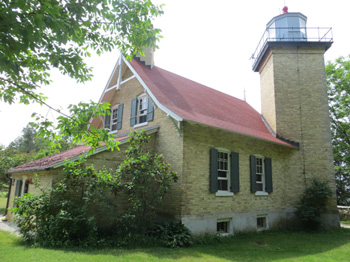
Door County, Wisconsin
by Megan Kopp
The rolling, tree-covered spit of land sticks out like a thumb into the treacherous waters of the Great Lake. So treacherous were the waters where Green Bay meets the open body of Lake Michigan, that it was given the name ‘Porte des Morts’ or ‘Death’s Door.’ The peninsula that would eventually become Door County has 300 miles (483 km) of shoreline. Dotting these shores with life-saving lighthouses to guide shipping vessels in the late 1800s and early 1900s was essential.
Light on the Rock
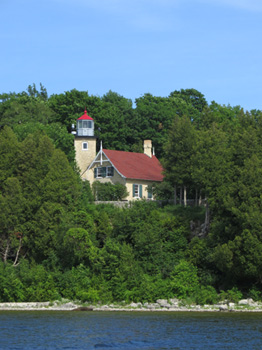 Severe weather, jagged shorelines and increasing shipping traffic led to the construction of Door’s first lighthouse in 1836. Pottawatomie Lighthouse was built high on the dolomite bluffs above Lake Michigan on Rock Island. The lighthouse was named after the Native Americans living in the area; it means ‘keepers of the fire.’
Severe weather, jagged shorelines and increasing shipping traffic led to the construction of Door’s first lighthouse in 1836. Pottawatomie Lighthouse was built high on the dolomite bluffs above Lake Michigan on Rock Island. The lighthouse was named after the Native Americans living in the area; it means ‘keepers of the fire.’
David E. Corbin – a veteran of the War of 1812 – became the first keeper in 1837. A bachelor, Corbin stayed at the isolated post guiding ships through stormy waters for 15 years. The original lighthouse was poorly built and the weathered structure was torn down and replaced just six years after Corbin left his position.
William Betts, Abraham Capers, James Fuller, Abraham Grover and Frank O. Sawyer were all keepers or assistant keepers of the light at Pottawatomie over the years – and they were all Civil War veterans. Lighthouse keepers were appointed by order of the President of the United States. The position was choice and veterans of the War of 1812 and the Civil War were given priority consideration. In addition to a yearly salary, keepers received free housing, yearly supplies of staples such as sugar and flour and a pension once they retired.
The U.S. Lighthouse Board was established the same year Corbin left the rock – and with it came a strict rulebook for lighthouse operation. Each morning, keepers were required to clean and polish the lens and refuel the lamp before 10 a.m.; the rest of the day was to be spent working the grounds, cleaning and painting the lighthouse and maintaining outbuildings. Day in, day out, this was the routine until the Rock Island light was automated in 1946.
Where Eagles Soar
The federal government built Eagle Bluff Lighthouse to safely guide ships through Green Bay’s narrow Strawberry Channel in 1868. The cream-colored Milwaukee brick, ‘Norman Gothic’ building on the 40-foot high bluff cost $12,000 to build. An unusual architectural feature of this lighthouse was the diagonally built tower jutting into the northwest corner of the house. Keeper Henry Stanley lit the tower’s original third-and-one-half order Fresnel lens on October 5th.
William Duclon, a Civil War Vet, served as Eagle Bluff’s second – and longest – keeper. Starting in 1883, William and his wife Julie raised seven sons while working and living for 35 years on the bluff. The lighthouse was automated in 1926.
Keepers of Cana Island
 William Jackson became the first keeper on Cana Island in November 3, 1869. His wife Caroline was the assistant keeper. William was paid $600/year for his work; Caroline received $400. These wages would remain the same for all keepers and their assistants for the next 30 years. William and Caroline left their positions in 1872.
William Jackson became the first keeper on Cana Island in November 3, 1869. His wife Caroline was the assistant keeper. William was paid $600/year for his work; Caroline received $400. These wages would remain the same for all keepers and their assistants for the next 30 years. William and Caroline left their positions in 1872.
When the light station was first built, Cana Island was a rocky point jutting into Lake Michigan. The tower was constructed of Cream City brick, as was the house. By the turn of the century, many of the bricks in the tower had been damaged from repeated storms. In 1902, the Lighthouse Board covered the tower in steel plates to stop the bricks from deteriorating further. The steel was then painted white.
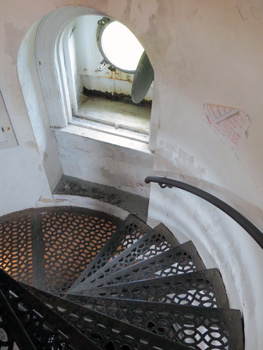 The one and a half storey keeper’s house was set up as a duplex – with the keeper and his family living on the first floor and his assistant and family on the second. In 1945, the light was automated and the last keeper left the island.
The one and a half storey keeper’s house was set up as a duplex – with the keeper and his family living on the first floor and his assistant and family on the second. In 1945, the light was automated and the last keeper left the island.
The Legacy
Today, these three lighthouses (of 11 in Door Country) are open on a regular basis, allowing visitors to climb their towers. From the ferry pier on Rock Island, it’s an uphill, one-mile walk through the woods to Pottawatomie Lighthouse. The Wisconsin Department of Natural Resource and the Friends of Rock Island formed a partnership to restore the building and surrounding landscape to how it looked in the early 1900s.
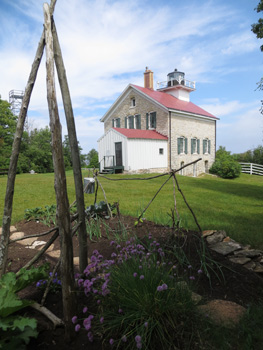 Volunteers spend a week at a time living (and working) in the restored lighthouse. They guide visitors through the building in addition to keeping the building spotlessly clean. The lantern room was removed in 1988 and the light now shines from a tall steel frame set away from the house. A replica lantern room is now open in the lighthouse and visitors can scramble up the steep wooden steps for view.
Volunteers spend a week at a time living (and working) in the restored lighthouse. They guide visitors through the building in addition to keeping the building spotlessly clean. The lantern room was removed in 1988 and the light now shines from a tall steel frame set away from the house. A replica lantern room is now open in the lighthouse and visitors can scramble up the steep wooden steps for view.
Eagle Bluff Lighthouse is easily accessed via a short paved path off the parking lot in Peninsula State Park. Eagle Bluff Lighthouse celebrates their 50th anniversary as a living museum on September 1, 2013. Join curator Patti Podgers and her paid docent staff – many of whom are former teachers – for fact-based tours of early keeper life.
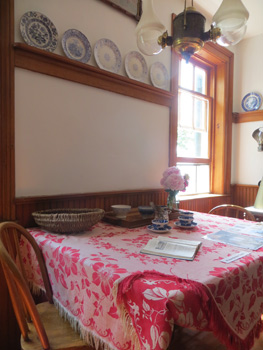 Walter Duclon’s guitar and his mother’s piano can be seen in the lighthouse today – refurbished by the Door County Historical Society to include a few of the Duclon family heirlooms. The walls are now whitewashed instead of the traditional layers of green or grey paint, but otherwise the restoration has taken the building back to what it looked like in the early 1900s.
Walter Duclon’s guitar and his mother’s piano can be seen in the lighthouse today – refurbished by the Door County Historical Society to include a few of the Duclon family heirlooms. The walls are now whitewashed instead of the traditional layers of green or grey paint, but otherwise the restoration has taken the building back to what it looked like in the early 1900s.
The once water-covered causeway of Cana Island is now high and dry and visitors can stroll up the old road after paying their entrance fee at the booth. On the left, tucked in thickets of Dame’s Rocket, is a weathered wood barn. The first building encountered is an old brick outhouse, closely followed by an octagonal-shaped oil house. An old stone wall built by a keeper during the 1920s to keep the waters of Lake Michigan at bay can still be found behind overgrown lilacs.
Volunteers of the Door County Maritime Museum maintain the buildings and grounds at Cana Island, control self-guided tours of the keepers house and climbs up the 97-step spiral staircase in the iconic tower and are ready and willing to answer visitor questions. Historic photos, hands-on exhibits and a short video help tell the story of the buildings.
If You Go:
♦ Travel information for Door County can be found online at: www.DoorCounty.com. There are small fees for tours and/or admittance to the lighthouses.
♦ The Door County Maritime Museum organizes the annual Lighthouse Festival events each June. Details for the festival can be found on the museum webesite at: www.dcmm.org/events-activities/special/annual-lighthouse-festival/.
About the author:
An avid traveller and freelance writer of 15 years, Megan enjoys actively experiencing history – whether climbing towering stairs or wandering through old family homes. She loves hearing passionate historians share tales – especially if they’re tall, but true!
All photographs are by Megan Kopp:
Eagle Bluff’s Norman Gothic design
Cana Island Lighthouse
Rock Island Lighthouse
Cana’s climb
A bird’s eye view of Eagle Bluff Lighthouse
The Duclon family plates and tablecloth grace the interior of the restored lighthouse




Leave a Reply
You must be logged in to post a comment.